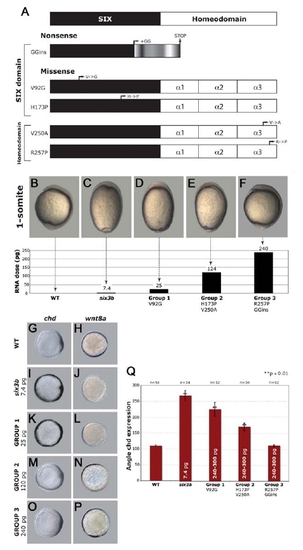- Title
-
Haploinsufficiency of Six3 fails to activate Sonic hedgehog expression in the ventral forebrain and causes holoprosencephaly
- Authors
- Geng, X., Speirs, C., Lagutin, O., Inbal, A., Liu, W., Solnica-Krezel, L., Jeong, Y., Epstein, D.J., and Oliver, G.
- Source
- Full text @ Dev. Cell
|
HPE-Associated Six3 Mutants Function as Hypomorphs (A–D) The five generated six3b HPE-related mutant forms can rescue the headless phenotype in injected hdl/tcf3-/- mutant embryos. ddH2O and mGFP (250 pg) were injected as negative controls. Rescue was scored at 55 hr postfertilization (hpf) according to three phenotypic categories: no rescue (yellow) (A), partial rescue (light blue) (B), and full rescue (dark blue) (C). The results are graphically represented in (D), which shows the samples and doses injected. (E–H) The six3b mutant forms show hypomorphic activity in suppressing the eyeless phenotype of six3b;six7 mutant morphants. The six3bvu87/vu87 mutants injected with six7 antisense morpholino oligonucleotide (MO) exhibit an eyeless phenotype. After coinjection of six3b mutants with six7 MO and six3b wild-type or mutant forms, embryos were graded according to the size of their eyes (0–6.5 point [pt] scale). Examples are shown of absent eyes (0 pt) (E), severely reduced eyes (arrowhead) (1.2 pt) (F), moderately reduced eyes (3.0 pt) (G), and full-size eyes (5.3 pt) (H). (I) Graphical interpretation of these results. The E109Stop null mutation found in six3bvu87 mutants was overexpressed as a negative control. Double asterisks indicate eye size significantly different from that of six3bvu87/vu87-six7 mutant morphants (p ≤ 0.01). The absence of asterisks on mutant form-injected samples indicates a p value that exceeds 0.05 (statistically insignificant). (J) Summary of the three zebrafish-based functional assays. Five HPE-associated Six3 mutants can be separated into three groups on the basis of their hypomorphic activity. PHENOTYPE:
|
|
HPE-Associated Six3 Mutants Function as Hypomorphs |
Reprinted from Developmental Cell, 15(2), Geng, X., Speirs, C., Lagutin, O., Inbal, A., Liu, W., Solnica-Krezel, L., Jeong, Y., Epstein, D.J., and Oliver, G., Haploinsufficiency of Six3 fails to activate Sonic hedgehog expression in the ventral forebrain and causes holoprosencephaly, 236-247, Copyright (2008) with permission from Elsevier. Full text @ Dev. Cell


